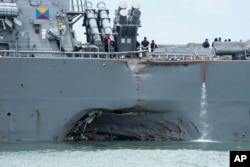Two collisions involving U.S. Navy destroyers and commercial vessels in the western Pacific earlier this year were “avoidable” and happened due to lax standards and poor preparation, according to the Navy’s top officer.
In a report made public on Wednesday, the Navy concluded that “numerous failures” on the part of leadership and the crews contributed to the deadly events. They included failing to plan for safety as well as failures in adhering to sound navigation practice and executing basic watch procedures.
"Both of these accidents were preventable,” Chief of Naval Operations Admiral John Richardson said. "We must do better."
The destroyer USS John S. McCain collided with an oil tanker in August off Singapore, leaving 10 U.S. sailors dead and five injured. The USS Fitzgerald, another destroyer, collided with a container ship in waters off Japan in June, killing seven sailors.
The collisions prompted the Navy to conduct reviews of its worldwide operations.
Before the reviews concluded, Richardson blamed the high pace of operations, budget uncertainty and naval leaders who put their mission over safety for the deadly incidents.
Richardson told the Senate Armed Services Committee in September that a failure of leadership throughout the service was the main contributing factor in the Navy's lack of readiness.
"I own this problem," Richardson testified.
The review found that during the incident involving the USS John S. McCain in the Straits of Singapore, the crew lost situational awareness in a busy maritime area due to mistakes in the operation of the ship’s steering and propulsion system. The crew also failed to follow what the review called “the international nautical rules of the road,” a system of rules governing vessel maneuvers when risk of collision is present. In addition, watchers operating the ship’s steering and propulsion systems were found to have insufficient proficiency and knowledge of those systems.
During the USS Fitzgerald incident southwest of Japan, the Navy found that the "watch teams" on the Fitzgerald's bridge failed to carry out basic maritime procedures. They also failed to notify the ship’s commanding officer when approaching nearby vessels, as required by Navy regulations, and they too failed to adhere by the international nautical rules of the road to remain clear of approaching vessels and, if possible, avoid crossing ahead of them.







